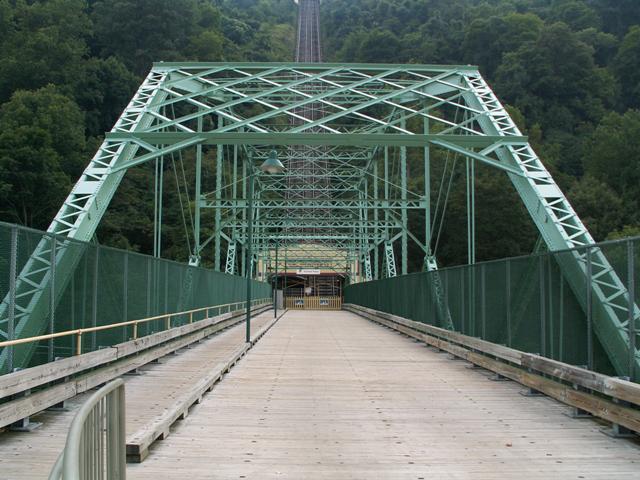We Recommend:
Bach Steel - Experts at historic truss bridge restoration.
BridgeHunter.com Phase 1 is released to the public! - Visit Now
Johnstown Incline Plane Bridge

Primary Photographer(s): Nathan Holth and Rick McOmber
Bridge Documented: August 1, 2007
Johnstown: Cambria County, Pennsylvania: United States
1890 By Builder/Contractor: Phoenix Bridge Company of Phoenixville, Pennsylvania
2001
230.0 Feet (70.1 Meters)
237.0 Feet (72.2 Meters)
16.7 Feet (5.09 Meters)
1 Main Span(s)
113022001000000

View Information About HSR Ratings
Bridge Documentation
View Archived National Bridge Inventory Report - Has Additional Details and Evaluation
View Historic American Engineering Record (HAER) Documentation For This Bridge
HAER Data Pages, PDF
View the National Register of Historic Places Nomination Form For This Bridge
View the National Register of Historic Places Nomination Form For The Incline
This bridge was built solely to provide access to the Johnstown Incline, which provides transportation up to what was originally a Cambria Iron Company sponsored residential development called Westmont. It was also created in response to the 1889 Johnstown Flood, since this facility could provide a way for residents of Johnstown to escape to high ground in the event of a flood. The bridge and incline did indeed later serve this purpose in a 1936 flood. As such, this bridge is significant for its association with the flood response, and with the incline which is a significant engineering feat in its own right, and one of very few remaining examples of an incline of this size.
This bridge itself is significant as an example of an uncommon and complex truss configuration, the Pennsylvania truss. The bridge has a rather wide deck for an 1890 bridge. The length of the bridge is significant, although it falls short of the average length for this truss configuration. It may be that this truss configuration was selected to give the bridge extra strength to withstand any floods.
The bridge has been rehabilitated over the years and as such some of the original design integrity has been lost. The observant bridge enthusiast may note these alterations. However, the overall materials and design of the bridge remains intact. The cyclone fence present on the bridge is perhaps the most notable and unsightly modern addition to the bridge. It would be nice to see this replaced with a barrier that does not obstruct the view of the truss and its details.
![]()
Photo Galleries and Videos: Johnstown Incline Plane Bridge
Bridge Photo-Documentation
A collection of overview and detail photos. This photo gallery contains a combination of Original Size photos and Mobile Optimized photos in a touch-friendly popup viewer.Alternatively, Browse Without Using Viewer
![]()
Maps and Links: Johnstown Incline Plane Bridge
Coordinates (Latitude, Longitude):
Search For Additional Bridge Listings:
Bridgehunter.com: View listed bridges within 0.5 miles (0.8 kilometers) of this bridge.
Bridgehunter.com: View listed bridges within 10 miles (16 kilometers) of this bridge.
Additional Maps:
Google Streetview (If Available)
GeoHack (Additional Links and Coordinates)
Apple Maps (Via DuckDuckGo Search)
Apple Maps (Apple devices only)
Android: Open Location In Your Map or GPS App
Flickr Gallery (Find Nearby Photos)
Wikimedia Commons (Find Nearby Photos)
Directions Via Sygic For Android
Directions Via Sygic For iOS and Android Dolphin Browser
USGS National Map (United States Only)
Historical USGS Topo Maps (United States Only)
Historic Aerials (United States Only)
CalTopo Maps (United States Only)



